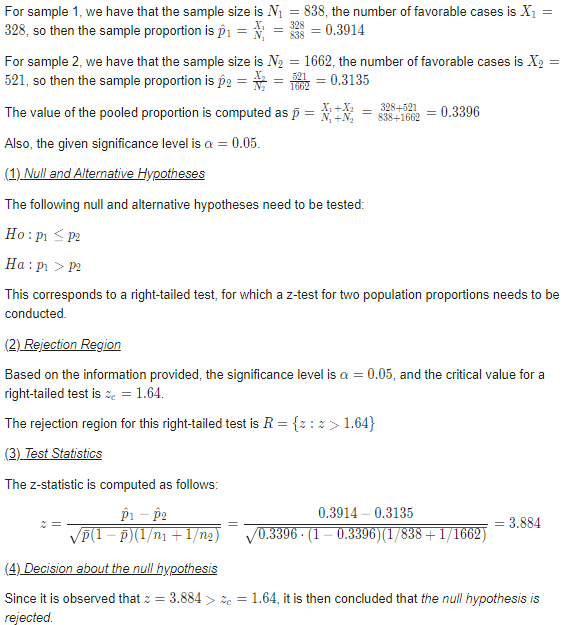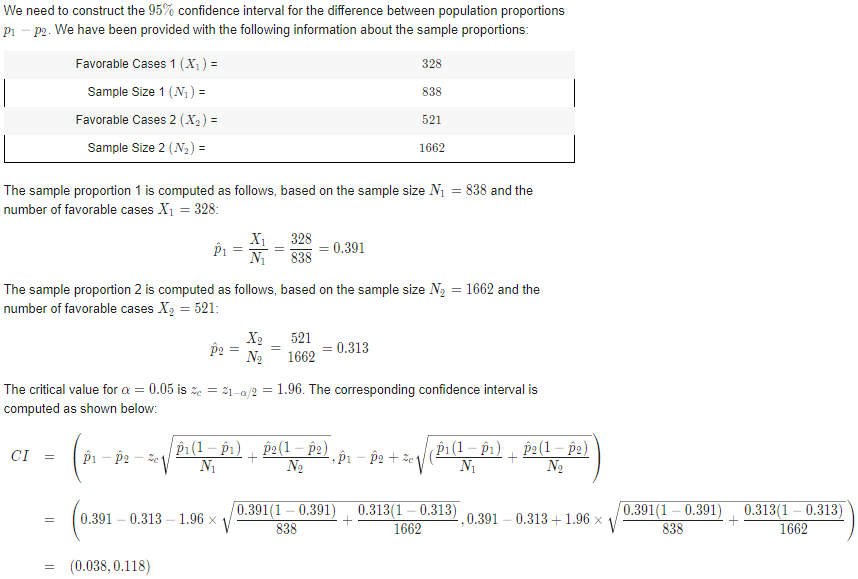Question
In: Math
Do out-of-state motorists violate the speed limit more frequently than in-state motorists? This vital question was...
Do out-of-state motorists violate the speed limit more frequently than in-state motorists? This vital question was addressed by the highway patrol in a large eastern state. A random sample of the speeds of 2,500 selected cars was categorized according to whether the car was registered in the state or in some other state and whether or not the car was violating the speed limit. The data follow.
In state speeding cars: 521
Out of state speeding cars: 328
In state not speeding cars: 1141
Out of state not speeding cars: 510
a.) Do these data provide enough evidence to support the highway patrol's claim at the 5% significance level? Your conclusion must be in terms of the P-Value. Show all necessary work.
b). What type of error is possible and describe this error in terms of the problem?
c). Estimate the difference in the actual percentage of In State and Out of State speed limit violators using a 95% confidence interval. Show all necessary work. Using this interval estimation, is there sufficient evidence to support the highway patrol's claim? Explain Carefully.
d). Carefully interpret the confidence interval estimation.
Use non-parametrics/Mann-Whitney test if the problem calls for it- Does it?
Solutions
Expert Solution
Answer a)
We will be using z test for two proportion to test the claim.
Let p1 represents proportion of out of state speeding car
Let p2 represents proportion of in state speeding car


Thus, it can be said that there is enough evidence to support the highway patrol's claim at the 5% significance level
Answer b)
In statistical hypothesis testing a type I error is the rejection of a true null hypothesis. . Thus, in this case Type I error is possible as null hypothesis is reject.
In this problem Type I error is rejecting null hypothesis even when true proportion of out of state speeding cars is less than or equal to true proportion of in state speeding cars.
Answer c)

Zero is the null value of the parameter (in this case the difference in proportions). If a 95% confidence interval does not includes the null value, then there is statistically meaningful or statistically significant difference between the two proportions. In addition, since difference in positive there is sufficient evidence to support the highway patrol's claim.
Answer d)
Based on the data provided, the 95% confidence interval for the difference between the population proportions of out of state speeding cars and in state speeding cars is 0.038<p<0.118, which indicates that we are 95% confident that the true difference between population proportions is contained by the interval (0.038,0.118).
Related Solutions
Do out-of-state motorists violate the speed limit more frequently than in-state motorists? This vital question was...
Do out-of-state motorists violate the speed limit more frequently than in-state motorists? This vital question was...
Do out-of-state motorists violate the speed limit more frequently than in-state motorists? This vital question was...
Seventy-five percent (75%) of vehicles on a freeway violate the speed limit. You randomly clock n...
why is scoliosis more frequently identified in females than in males? why do you think females...
A state highway goes through a small town where the posted speed limit drops down to...
much more frequently than this (that is OK and encouraged). After posting, make sure to return...
Balding and color blindness are genetic mutations that occur more frequently in males than females. This...
Why might it be useful for a company to evaluate its prices more frequently than once...
Question #2. Airline Scheduling Alpha Airline wishes to schedule no more than one flight out of...
- A small entrepreneurial company is trying to decide between developing two different products that they believe...
- A conducting metallic spherical shell of inner radius a and outer radius b has a net...
- 3b. Describe the versatility of the glucose phosphate molecule. 3b. How do plants utilize this molecule?...
- A cross-country pipeline transports crude oil at a rate of 500,000 barrels per day. The pressure...
- Today I read articles and texts about Dirac monopoles and I have been wondering about the...
- The equilibrium constant (KP) is 0.16 at a particular temperature for the reaction: N2O4(g) ⇌ 2NO2(g)...
- Why have we not seen a US-based terrorist organization established with the goal to see the...
 milcah answered 1 month ago
milcah answered 1 month ago